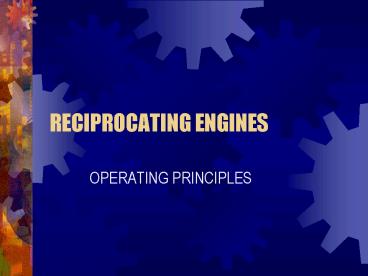RECIPROCATING ENGINES - PowerPoint PPT Presentation
1 / 19
Title:
RECIPROCATING ENGINES
Description:
The intake valve opens as the piston moves downward sucking the fuel/air charge ... Shaft horsepower is measured with a dynamometer. IHP-FHP=SHP ... – PowerPoint PPT presentation
Number of Views:881
Avg rating:5.0/5.0
Title: RECIPROCATING ENGINES
1
RECIPROCATING ENGINES
- OPERATING PRINCIPLES
2
Operating cycle
- The operating cycle of a reciprocating engine
include 5 events - Intake
- Compression
- Ignition
- Power
- Exhaust
3
Four-Stroke Cycle
- Most aircraft reciprocating engines utilize the
four-stroke cycle - Intake
- Compression
- Power
- Exhaust
4
Four-Stroke Five-Event Cycle
5
INTAKE STROKE
- The intake valve opens as the piston moves
downward sucking the fuel/air charge into the
combustion chamber.
6
COMPRESSION STROKE
- The intake and exhaust valves are closed as the
piston moves upward compressing the fuel/air
charge.
7
IGNITION EVENT
- The intake and exhaust valves are closed asthe
spark plug fires igniting the compressed fuel/air
charge.
8
POWER STROKE
- The intake and exhaust valves are closed as the
piston is forced downward by the rapid expansion
of the burning fuel/air charge.
9
EXHAUST STROKE
- The exhaust valve opens as the piston moves
upward forcing the burned exhaust gases out of
the cylinder.
10
(No Transcript)
11
DEFININTIONS
- Top Dead Center (TDC) The position of the piston
at its highest point in a upward stroke. - Bottom Dead Center (BDC) The position of the at
its lowest point in a downward stroke. - Stroke The distance the piston moves from TDC to
BDC. - Bore The inside diameter of the cylinder.
- Piston Displacement The volume displaced by the
piston. - Compression Ratio A comparison of the difference
in cylinder volume between TDC and BDC.
12
Valve Timing
- Intake valves The intake valves are timed to
open before the piston reaches TDC on the exhaust
stroke. The speed of the exhaust gases leaving
the combustion chamber create a low pressure
which helps suck the fuel/air mixture into the
chamber. By opening prior to TDC the engine
maximizes the intake of fuel/air mixture to
increase horsepower. If the engine is timed to
open the intake valves too early in the exhaust
stroke, some of the hot exhaust gases may enter
the intake manifold igniting the fuel/air
mixture. (backfire)
13
Valve Timing
- Exhaust valves The exhaust valves are timed to
open before the piston reaches BDC on the power
stroke. This way exhaust gases start evacuating
the cylinder to residual pressure in the
cylinder. It aids in complete removal of waste
heat once the useful energy of expansion has been
used. Complete removal of exhaust gas before the
intake stroke is essential to providing an
undiluted fuel/air charge.
14
ENGINE POWER AND EFFICIENCY
- Work force times distance. Work is commonly
measured by the foot-pound. (1lb mass raised 1ft
1ft-lb of work) - Horsepower common unit of mechanical power.
(HPft-lb per min/33,000) - Indicated Horsepower (IHP) the power developed
in the combustion chambers without reference to
friction losses within the engine.
15
ENGINE POWER AND EFFICIENCY
- Brake Horsepower (BHP) the power delivered to
the propeller shaft takes power loss due to
friction and engine driven accessories
(generator, alternator, A/C, oil pumps, fuel
pumps, etc.) into account. Brake horsepower is
measured with a Prony brake. IHP-FHPBHP
16
ENGINE POWER AND EFFICIENCY
- Shaft Horsepower (SHP) the power delivered to
the propeller shaft takes power loss due to
friction and engine driven accessories
(generator, alternator, A/C, oil pumps, fuel
pumps, etc.) into account. Shaft horsepower is
measured with a dynamometer. IHP-FHPSHP - NOTE BHP and SHP are commonly used as
interchangeable terms. The only difference being
the technicality of what type of device was used
to measure engine output.
17
ENGINE POWER AND EFFICIENCY
- Friction Horsepower (FHP) the power loss in an
engine due to friction between moving parts,
drawing in fuel, expelling exhaust, and engine
driven components.
18
ENGINE POWER AND EFFICIENCY
- Equivalent Shaft Horsepower (ESHP) shaft
horsepower plus additional thrust provided by
exhaust gases directed rearward on turboprop
engines. - Thrust Horsepower (THP) the result of the engine
and propeller working together. Propeller
efficiency varies with engine speed, altitude,
attitude, temperature, and airspeed.
THPBHPPropeller Efficiency.
19
- Engine efficiency is measured in three ways
- Thermal efficiency ratio of the useful work done
by the engine to the amount of heat energy
developed by combustion. - Mechanical efficiency ratio that shows how much
of the power developed by the combustion process
is delivered to the output shaft. BHP/IHP - Volumetric efficiency comparison of the volume
of fuel/air charge inducted into the cylinder to
piston displacement. Varies due to atmospheric
conditions and complete or incomplete removal of
exhaust gases from the cylinder.































